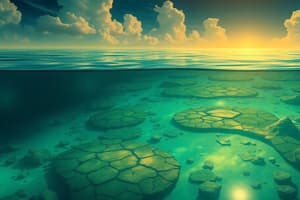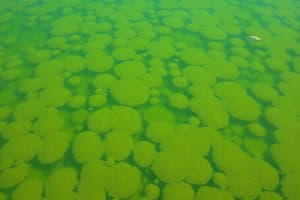Podcast
Questions and Answers
What is a direct consequence of algal blooms in coastal regions?
What is a direct consequence of algal blooms in coastal regions?
- Reduction of nutrient levels in the seawater
- Increased diversity of marine life
- Enhanced photosynthesis by sea plants
- Formation of dead zones (correct)
Which of the following is NOT a major contributor to ocean pollution?
Which of the following is NOT a major contributor to ocean pollution?
- Sewage disposal from cities
- Microplastics from heavy machinery (correct)
- Improper disposal of radioactive waste
- Oil spills from tanker accidents
How does marine pollution primarily affect marine food webs?
How does marine pollution primarily affect marine food webs?
- It increases fish populations in affected areas
- It leads to the accumulation of toxins in marine organisms (correct)
- It enhances the reproductive rates of marine species
- It creates more diverse ecosystems
What is one of the socio-economic impacts of marine pollution?
What is one of the socio-economic impacts of marine pollution?
What role does excessive chemical fertilizer play in marine pollution?
What role does excessive chemical fertilizer play in marine pollution?
Radioactive waste disposal can lead to which of the following?
Radioactive waste disposal can lead to which of the following?
Which marine organism is most likely to be impacted by solid waste, particularly plastics?
Which marine organism is most likely to be impacted by solid waste, particularly plastics?
What is a key process in the creation of dead zones in aquatic environments?
What is a key process in the creation of dead zones in aquatic environments?
What is a leading cause of health risks related to marine pollution?
What is a leading cause of health risks related to marine pollution?
What happens to marine plants and algae during an algal bloom?
What happens to marine plants and algae during an algal bloom?
Flashcards
Eutrophication
Eutrophication
The process where excessive nutrients from sources like sewage and fertilizers cause rapid growth of algae, leading to oxygen depletion and the formation of 'dead zones' where most life can't survive.
Food Web Contamination
Food Web Contamination
The accumulation of heavy metals and toxic chemicals in marine organisms, increasing in concentration along the food chain.
Sewage Pollution
Sewage Pollution
The discharge of untreated or poorly treated sewage into the ocean, leading to excessive nutrients and potential dead zones.
Oil Spill
Oil Spill
Signup and view all the flashcards
Solid Waste Pollution
Solid Waste Pollution
Signup and view all the flashcards
Radioactive Pollution
Radioactive Pollution
Signup and view all the flashcards
Decline in Tourism
Decline in Tourism
Signup and view all the flashcards
Health Risk
Health Risk
Signup and view all the flashcards
Loss of Recreational Activities
Loss of Recreational Activities
Signup and view all the flashcards
Threatening Marine Life
Threatening Marine Life
Signup and view all the flashcards
Study Notes
Dead Zones in the Gulf of Mexico
- The area of dead zones in the Gulf of Mexico increased from 1000 to 14000 between 1985 and 2013, a 440% increase.
- Intensive farming is a major source of phosphorus and nitrogen in the Gulf of Mexico.
- These nutrients lead to eutrophication, causing algal blooms.
- Algae die and decompose. This process uses up oxygen, creating hypoxic (low oxygen) conditions.
- Dead zones form, and fish cannot survive.
- Coral bleaching and fish deaths are observed due to dead zones.
- Causes of dead zones are:
- Excessive chemical fertilizers from intensive farming
- Improper waste disposal
- Poorly treated sewage
- Oil Spills from land to sea
Socio-economic Impacts of Dead Zones
- Reduced tourism
- Increased healthcare costs from food poisoning.
- Reduced recreational activities due to polluted coastal areas.
- Decreased revenue in the fishing industry.
Alleviating Dead Zones
- Sustainable farming practices
- Intercropping
- Sewage treatment before discharge
- Reducing oil spills
Oil Spill Impact on Seabirds
- Oil absorption increases the weight of feathers.
- Feathers are crucial for thermoregulation in seabirds.
- Oil can affect the feather's insulating ability, increasing their susceptibility to temperature changes.
- Seabirds preen to clean their feathers, but oil accumulation hinders this.
- Ingestion of oil can induce health problems in seabirds.
Studying That Suits You
Use AI to generate personalized quizzes and flashcards to suit your learning preferences.




